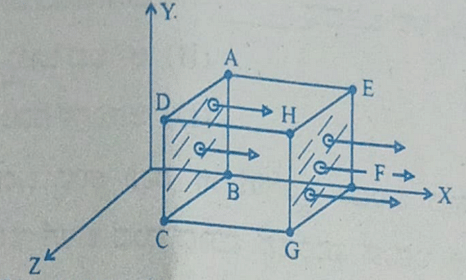An electric field \( \vec{E} = (2x \hat{i}) \, \text{N C}^{-1} \) exists in space. A cube of side \( 2 \, \text{m} \) is placed in the space as per the figure given below. The electric flux through the cube is __________ \( \text{N m}^2/\text{C} \).
Correct Answer: 16
Approach Solution - 1
The electric flux (Φ) through a closed surface such as a cube can be calculated using Gauss's law: \( Φ = \oint \vec{E} \cdot d\vec{A} \), where \( \vec{E} \) is the electric field, and \( d\vec{A} \) is the differential area vector. Given the electric field \( \vec{E} = (2x \hat{i}) \, \text{N C}^{-1} \), the flux through surfaces perpendicular to other axes will be zero because the field is only in the x-direction.
Consider the cube positioned from \( x = 0 \) to \( x = 2 \) with side length \( a = 2 \, \text{m} \). The cube has two faces perpendicular to the x-axis at \( x = 0 \) and \( x = 2 \). The area \( A \) of each face is \( A = 2 \times 2 = 4 \, \text{m}^2 \).
For the face at \( x = 0 \):
\( \vec{E} = 2(0) \hat{i} = 0 \) so flux, \( Φ_0 = E \cdot A = 0 \times 4 = 0 \, \text{N m}^2/\text{C} \).
For the face at \( x = 2 \):
\( \vec{E} = 2(2) \hat{i} = 4 \, \text{N C}^{-1} \) and outward \( d\vec{A} = 4 \hat{i} \), so flux, \( Φ_2 = E \cdot A = 4 \times 4 = 16 \, \text{N m}^2/\text{C} \).
The total flux through the cube is \( Φ_{\text{total}} = Φ_0 + Φ_2 = 0 + 16 = 16 \, \text{N m}^2/\text{C} \).
The computed value \( 16 \, \text{N m}^2/\text{C} \) falls within the expected range of (16,16).
Approach Solution -2
The electric flux is given by Gauss's Law:
\(\Phi = \oint \vec{E} \cdot d\vec{A}.\)
The field $\vec{E} = 2x \hat{i}$ varies with $x$.
For the cube, only the left ($x = 0$) and right ($x = 2$) faces contribute: \(\Phi = E_\text{right} A - E_\text{left} A.\)
Substituting $A = 4 \, \mathrm{m}^2$, $E_\text{right} = 2(2) = 4$, and $E_\text{left} = 2(0) = 0$:
\(\Phi = 4 \cdot 4 - 0 \cdot 4 = 16 \, \mathrm{Nm}^2/\mathrm{C}.\)
Top Questions on Gauss Law
- If the net flux through a cube is 1.05 N m\(^2\) C\(^{-1}\), what will be the total charge inside the cube? (Given: The permittivity of free space is \(8.85 \times 10^{-12}\) C\(^2\) N\(^{-1}\) m\(^{-2}\)).
- CUET (UG) - 2025
- Physics
- Gauss Law
- A charge q is placed at the center of one of the surface of a cube. The flux linked with the cube is :-
- JEE Main - 2024
- Physics
- Gauss Law
- There are two cubical Gaussian surface carrying charges as shown. Find ratio of fluxes through surface \(C_1\) and \(C_2\):

- JEE Main - 2024
- Physics
- Gauss Law
- Match List I with List IIChoose the correct answer from the options given below:
LIST I LIST II A Gauss's Law in Electrostatics I \(\oint \vec{E} \cdot d \vec{l}=-\frac{d \phi_B}{d t}\) B Faraday's Law II \(\oint \vec{B} \cdot d \vec{A}=0\) C Gauss's Law in Magnetism III \(\oint \vec{B} \cdot d \vec{l}=\mu_0 i_c+\mu_0 \in_0 \frac{d \phi_E}{d t}\) D Ampere-Maxwell Law IV \(\oint \vec{E} \cdot d \vec{s}=\frac{q}{\epsilon_0}\) - JEE Main - 2023
- Physics
- Gauss Law
- A cubical Gaussian surface has side of length a = 10 cm. Electric field lines are parallel to x-axis as shown. The magnitudes of electric fields through surfaces ABCD and EFGH are 6kNC-1 and 9kNC-1 respectively. Then the total charge enclosed by the cube is
[Take ε0 = 9 × 10-12 Fm-1]
- KCET - 2023
- Physics
- Gauss Law
Questions Asked in JEE Main exam
- An AC current is represented as: $ i = 5\sqrt{2} + 10 \cos\left(650\pi t + \frac{\pi}{6}\right) \text{ Amp} $ The RMS value of the current is:
- JEE Main - 2025
- AC Circuits
Let \( f : \mathbb{R} \to \mathbb{R} \) be a twice differentiable function such that \[ (\sin x \cos y)(f(2x + 2y) - f(2x - 2y)) = (\cos x \sin y)(f(2x + 2y) + f(2x - 2y)), \] for all \( x, y \in \mathbb{R}. \)
If \( f'(0) = \frac{1}{2} \), then the value of \( 24f''\left( \frac{5\pi}{3} \right) \) is:
- JEE Main - 2025
- Differential Calculus
- The number of points of discontinuity of the function $ f(x) = \left\lfloor \frac{x^2}{2} \right\rfloor - \left\lfloor \sqrt{x} \right\rfloor, \quad x \in [0, 4], $ where $ \left\lfloor \cdot \right\rfloor $ denotes the greatest integer function, is:
- JEE Main - 2025
- Functions
- A lens of focal length 20 cm in air is made of glass with a refractive index of 1.6. What is its focal length when it is immersed in a liquid of refractive index 1.8?
- JEE Main - 2025
- Wave optics
- Two charges \( 7 \, \mu C \) and \( -4 \, \mu C \) are placed at \( (-7 \, \text{cm}, 0, 0) \) and \( (7 \, \text{cm}, 0, 0) \) respectively. Given, \( \epsilon_0 = 8.85 \times 10^{-12} \, \text{C}^2 \text{N}^{-1} \text{m}^{-2} \), the electrostatic potential energy of the charge configuration is:
- JEE Main - 2025
- Electrostatics and Potential Energy